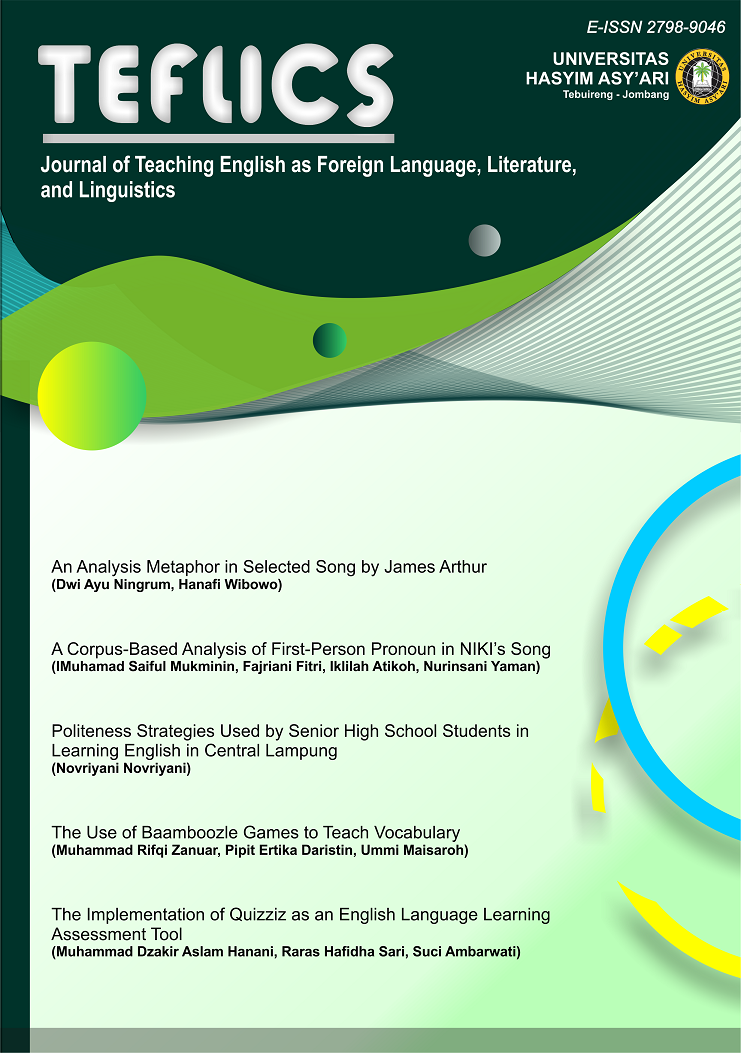POLITENESS STRATEGIES USED BY SENIOR HIGH SCHOOL STUDENTS IN LEARNING ENGLISH IN CENTRAL LAMPUNG
DOI:
https://doi.org/10.33752/teflics.v4i2.7501Keywords:
pragmatics, politeness strategy, students’ interactionAbstract
Students interaction used politeness strategy helping learners develop the ability to communicate appropriately in different situations research was aimed to analyze the politeness strategies used by the students of senior high school. Politeness is an essential element of communication and is used to assure the quality of a relationship through language. Politeness in English classes is paramount to study because the sense of decency is indispensable. In another condition, virtual communication to some extent is challenging since it requires some rules to run proper interactions between lecturers and students. This involved descriptive qualitative research in which the research participants were forty participants. The data were spoken utterances of students performance. The data of politeness were analyzed based on (Brown & Levinson, 1987a). To achieve the purpose of study, the researcher used observation. The observation was done to observed and recorded of teaching and learning process. The research findings showed that Indonesian EFL learners tended to express annoyance when they made complaints. As for politeness, they mostly used bald on record and positive politeness. Social distance (D), rather than relative power (P), tended to influence the strategies of complaint and politeness
Downloads
References
Adel, S. M. R., Davoudi, M., & Ramezanzadeh, A. (2016). A Qualitative Study of Politeness Strategies Used by Iranian EFL Learners in a Class Blog. Iranian Journal of Language Teaching Research, 4(1), 47–62. http://ijltr.urmia.ac.ir/article_20377_53eda177edc86c d185e9637aa6a9bf7e.pdf
Bachman, L. F. (1990). Fundamental considerations in language testing. Oxford: Oxford University Press.
Brown, P. &Levinson, S.C. (1987).Politeness: Some universals in Language Usage. Cambridge and New York: Cambridge University Press.
Carolus, A., Muench, R., Schmidt, C., & Schneider, F. (2019). Impertinent mobiles - Effects of politeness and impoliteness in human-smartphone interaction. Computers in Human Behavior, 93, 290–300. https://doi.org/10.1016/j.chb.2018.12.030
Coulmas, Florian. (1997). The Handbook of Sociolinguistics. Oxford. Blackwell Publisher.
Crystal, D. (2004). The Cambridge encyclopedia of the English language: Ernst Klett Sprachen.
Ellis, Rod. (1994). The Study of Second Language Acquisition. Oxford: Oxford University Press.
Fitriyani, S., & Andriyanti, E. (2020). Teacher and Students’ Politeness Strategies in EFL Classroom Interactions. IJELTAL (Indonesian Journal of English Language Teaching and Applied Linguistics), 4(2), 259. https://doi.org/10.21093/ijeltal.v4i2.473
Kerbrat-Orecchioni, C. (2011). From good manners to facework. Journal of Historical Pragmatics, 12(1–2), 133–155. https://doi.org/10.1075/jhp.12.1-2.06ker
Kasper, Gabriel. (2000). Linguistic Etiquette. Dalam Florian Coulmas (ed), The Handbook of Sociolingustics. Oxford: BlackWell Publisher. (374-385).
Koshik, Irene. (2003). Wh-questions used as challenges. Discourse Studies, 5(1), 51-77.http://dx.doi.org/10.1177/1461445603005001839
Kuntsi, P. (2012). Politeness and Impoliteness Strategies Used by Lawyers in the ‘Dover Trail’- A Case Study. Available http: www.epublications.uef.fi/pub/urn_nbn_fi.../urn_nbn_fi_uef-20120273.pdf (4 September 2013).
Lakoff. (1973). Language and Woman’s Place. Language in Society. Vol. 2, No. 1, pp. 45-80
Leech. G. (1983). Principles of Pragmatic. Walking and Talking Victims of Strangulation: is there a new epidemic? London, Longman.
Leech. Geofrey N. (1983). Principle of Pragmatics. New York: Longman Inc.
Llamas, Carmen, dkk. (2007). The Routledge Companion to Sociolinguistics. London and New York: Routledge.
Mahmud, M. (2019). The use of politeness strategies in the classroom context by English university students. Indonesian Journal of Applied Linguistics, 8(3), 597– 606. https://doi.org/10.17509/ijal.v8i3.15258
Marina Terkourafi. (2003). Three levels in Politeness Theory and Practice, British school at Athens, Greece& University of Cambridge, U.K.
Maros, M., & Rosli, L. (2017). Politeness Strategies in Twitter Updates of Female English Language Studies Malaysian Undergraduates. 23(1), 132–149. https://doi.org/http://doi.org/10.17576/3L-2017-2301- 10
Muslich, Masnur. (2006). Kesantunan Berbahasa: Sebuah Kajian Sosiolinguistik. Pendidikan Network (Online). Access on 5 Agustus 2012. http://www.Artikel Pendidikan Network – Kesantunan Berbahasa.htm.
Pennings, H. J. M., van Tartwijk, J., Wubbels, T., Claessens, L. C. A., van der Want, A. C., & Brekelmans, M. (2014). Real-time teacher–Student interactions: A dynamic systems approach. Teaching and Teacher Education, 37, 183–193.
Rashidi, N. (2010) Analyzing Patterns of Classroom Interaction in EFL Classrooms in Iran. The journal of asia TEFL Vol. 7, No. 3, pp. 93-120, Autumn research projects. Education for Information 22, 63–75.
Renkema, Jan. (1993). Discourse Studies: An Introductory Textbook. Amsterdam/Philadelphia: John Benjamins Publishing Company.
Rejeki, S., & Azizah, A. N. (2019). Politeness Strategies Performed by efl learners ’ with english native speakers in medical students. Humaniora, 10(1), 41–46. https://doi.org/10.21512/humaniora.v10i1.5312
Rohaedi, D. Wahyudin. (2009). Kesantunan Berbahasa di Ruang Kelas. Dalam Anshori, Dadang S., dkk (ed). Wacana Bahasa: Mengukukuhkan Identitas Bangsa. Bandung: Jurusan Pendidikan Bahasa dan Sastra Indonesia FPBS UPI.
Santoso, et. al (2021). The positive politeness strategies used on whatsapp conversation between student and teacher in English learning at al-luthfah Islamic school. International Journal of Education and Learning ISSN 2684-9240 Vol. 3, No. 2, August 2021, pp. 145-155
Sapitri, P. A., Chasanah, A., Putri, A. A., & Paulima, J. (2020). Exploring Brown and Levinson’s Politeness Strategies: An Explanation on the Nature of the Politeness Phenomenon. REiLA : Journal of Research and Innovation in Language, 1(3), 111–117. https://doi.org/10.31849/reila.v1i3.3801
Sembiring, E., & Sianturi, S. (2019). Politeness Strategies in EFL Classroom Context: Avoiding Future Conflict and Maintain the Harmony of Diversity. Utamax : Journal of Ultimate Research and Trends in Education, 1(3), 105–111. https://doi.org/10.31849/utamax.v1i3.6257
Su, H. (2019). The metapragmatics of Taiwanese ( im ) politeness : Conceptualization and evaluation of limao. Journal of Pragmatics, 148, 26–43. https://doi.org/10.1016/j.pragma.2019.05.018
Sundari, H.,(2017) Classroom Interaction in Teaching English as Foreign Language at Lower Secondary Schools in Indonesia. Advances in Language and Literary Studies ISSN: 2203-4714
Trosborg, Anna. 1995. Interlanguage Pragmatics : Request, Complaints, and Apologies. Berlin:Mouton de Gruyter.
Usó-Juan, E., & Martínez-Flor, A. (2006). Current trends in the development and teaching of the four language skills. Berlin: Walter de Gruyter.
Yusuf, R., & Anwar, A. (2019). An Article Review on “ The Use of Politeness Strategies in the Classroom Context by English University Students .” ELSYA: Journal of English Language Studies, 1(2), 69–73. https://doi.org/https://doi.org/10.31849/elsya.v1i2.353 0
Wardaugh, Ronald. 2006. An Inroduction to Sociolinguistics, Fifth Edition. Oxford: BlackWell Publisher.
Yule, George. 1996.Pragmatics.New York : Oxford University Press

Downloads
Published
How to Cite
Issue
Section
License
Copyright (c) 2024 Teaching English as Foreign Language, Literature and Linguistics

This work is licensed under a Creative Commons Attribution-ShareAlike 4.0 International License.















